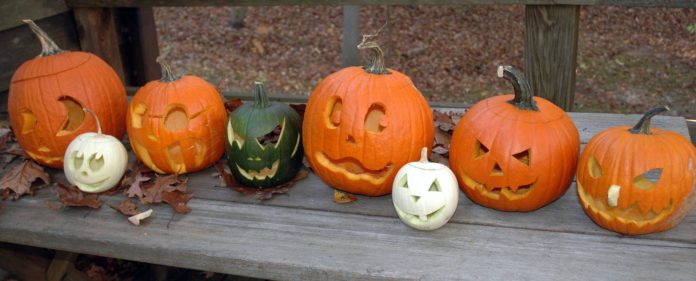
It can be frustrating to put a bunch of time and effort into carving a pumpkin only for it to be shriveled and covered in mold on Halloween night.
But it doesn’t have to be that way — your pumpkin can be healthy and bright for trick-or-treaters. Follow the 8 pumpkin carving tips below to make sure your squash is spooktacular on Halloween.
It starts with a stem
Having a beautiful carved pumpkin on your porch or patio for Halloween starts at the pumpkin patch.
When you’re choosing your pumpkin, the University of Illinois Extension Office recommends picking one with a stem at least 1 to 2 inches long. Pumpkins without a stem don’t last as long as pumpkins with a stem.
Also make sure your pumpkin is free of major dejects like punctures, holes and soft spots.
Color matters
Ultimately, there is no wrong color of pumpkin to choose, but color does matter. If you’re looking for a pumpkin that’s easier to carve, look out for a lighter orange, the Extension Office said. If you don’t mind working a little harder while carving so that you ensure your pumpkin lasts a couple weeks, choose a darker orange pumpkin.
Prepare your carving tools
You can buy a pumpkin carving tool set or you can choose an array of other tools. You’ll definitely need a serrated knife, a boning knife and a scraper to scoop out guts and seeds at the very least. There are several Pinterest tips for using drills and cookie cutters, and you may also consider using a dremel tool, linoleum cutters or wood chisels, depending on how complex your design is.
Whatever you use, make sure to clean the tools with hot water and soap so that the cuts are clean.
Carve your pumpkin
Well what are you waiting for? Get to work! Carve your pumpkin about 7 to 10 days before Halloween (or sooner) to ensure that your squash will still look good on the big night, the Extension Office said.
Clean your pumpkin
Your pumpkin needs a thorough cleaning that removes dirt as well as bacteria in order for the pumpkin to stay fresh and firm for Halloween (and perhaps beyond).
Bleach is the best cleaner to use because it will kill mold and other bacteria and prevent mold from growing again. Mother Nature Network recommends dipping your pumpkin (preferably after carving) in a solution of water and bleach (1 tablespoon bleach to 1 gallon of water) or spraying the pumpkin with a bleach-water solution. Let the pumpkin air dry after.
Of course, that means you won’t be able to eat your pumpkin after Halloween. If you do want to be able to eat the pumpkin (or you think wild animals might try to take a bite), add a few drops of tea tree oil and grapefruit seed extract to water and spray it on the pumpkin to clean. Again, air dry after.
Lube it up
You read that right. After you’re done carving and cleaning your pumpkin, it’s also a good idea to apply a water-repelling lubricant to the cut edges to keep the pumpkin fresh, Mother Nature Network said.
Petroleum jelly and WD-40 are both good options, but you can use vegetable oil or olive oil if you plan on eating the pumpkin after Halloween.
Light it up
Of course you want to have your pumpkin lit on Halloween night, but a candle isn’t necessarily a good idea. Candles — including tea light candles — can cook the pumpkin’s flesh, according to The Extension Office.
Instead, use battery-operated flashlights and candles. If you really must use a candle to achieve the spooky glow you want, limit it to the night when trick-or-treaters will be stopping by for candy.
Protect your pumpkin from Mother Nature
In the day(s) between carving and Halloween night, make sure your pumpkin isn’t left outside to deal with weather unprotected. Hot sunlight, rain, freezing cold and snow can all do damage to your squash. Store your pumpkins in your garage if the weather seems like it may be unfriendly.




